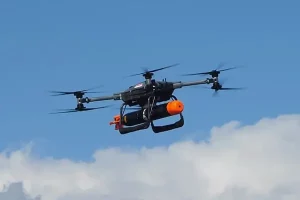Bengaluru is facing a worsening water crisis, leading to significant shortages in various areas. According to the reports, 223 of the 236 talukas in Karnataka are affected by drought, including Mandya and Mysuru districts, the sources of Bengaluru’s water.
Bengaluru Water Crisis
Why In News
- Bengaluru is facing a worsening water crisis, leading to significant shortages in various areas. According to the reports, 223 of the 236 talukas in Karnataka are affected by drought, including Mandya and Mysuru districts, the sources of Bengaluru’s water.
- As summer intensifies, about 7,082 villages across Karnataka are at risk of witnessing a drinking water crisis in the coming months. With the depletion of underground water and drought in the Cauvery basin, Bengaluru city is staring at a Cape Town-like water crisis this year.
Some Facts
- Bengaluru requires nearly 1,450 million litre per day (MLD) of water from the Cauvery and an additional 700 mld from groundwater resources.
- However, with both sources going dry, several distress calls have been coming in from various industries, institutions, and residents.
- The water crisis in the city has impacted large apartments, gated communities, government and private schools, fire brigades, hotels and restaurants, which are reeling under severe shortages due to the demand and supply gap.
- According to reports, 6,997 out of 14,700 borewells have dried up in Bengaluru. The crisis expected to worsen during the summer months. According to The Bengaluru Water Supply and Sewerage Board (BWSSB), which supplies drinking water to the city, the water input to the city has fallen by 50 percent.
- Officials stated that the city requires approximately eight thousand million cubic feet (TMC) of water from March to May, yet there are only 34 TMC of water available in the reservoirs.
Why Does Bangalore Face Water Scarcity ?
Declining Rainfall and Dwindling Reservoirs:
- Recent monsoons have brought inadequate rainfall to the city, impacting the Cauvery River, a vital water source. Decreased river levels mean less water for drinking and agriculture.
- Karnataka experienced a 38% shortfall in northeast monsoon rains from October to December, along with a 25% deficit in southwest monsoon rainfall from June to September.
- According to the Karnataka State Natural Disaster Management Centre (KSNDMC), key reservoirs in the Cauvery Basin like Harangi, Hemavathi, and Kabini are currently at 39% of their total capacity in 2024.
Decline in Groundwater:
- The rapid urbanization of Bengaluru has led to the paving over of natural areas that once absorbed rainwater, reducing groundwater replenishment and increasing surface runoff.
- Residents now heavily rely on borewells for water, but with diminishing rainfall and excessive extraction, groundwater levels are plummeting, causing many borewells to dry out.
Infrastructure Shortcomings:
- Bengaluru’s infrastructure, including water supply and sewage systems, has struggled to keep pace with its rapid expansion. This deficiency exacerbates the challenge of efficiently distributing water to meet the needs of the growing population.
- The completion of Phase-5 of the Cauvery project, slated to provide 110 liters of drinking water per day to 1.2 million people, is expected by May 2024.
Impact of Climate Change:
- Shifting weather patterns, such as erratic rainfall and prolonged droughts linked to climate change, have further reduced water availability in Bengaluru’s reservoirs and natural water sources.
- The Indian Meteorological Department attributes the region’s scant rainfall to the El Niño phenomenon.
Water Body Pollution:
- Industrial discharge, untreated sewage, and waste dumping have contaminated water sources, making them unsuitable for consumption and further reducing the available water supply.
- A study by the Environmental Management & Policy Research Institute (EMPRI) reveals that approximately 85% of Bengaluru’s water bodies are polluted by industrial effluents, sewage, and waste dumping.
Mismanagement and Unequal Distribution:
- Ineffective water management practices, such as wastage, leaks, and unequal resource distribution, worsen the severity of the water scarcity crisis, leaving some areas with inadequate or irregular water supply.
Legal and Political Complexities:
- Disputes over water sharing between Karnataka and neighboring states, particularly concerning rivers like the Cauvery, add complexity to efforts to manage and secure water resources for Bengaluru’s residents.
- Ongoing disagreements between central and state governments regarding the allocation of funds to address Karnataka’s drought situation further complicate the issue.
What can be done ?
The Interlinking of Rivers:
- The national interlinking of rivers (ILR) is the idea that rivers should be inter-connected, so that water from the surplus rivers and regions could be transferred to deficient regions and rivers to address the issue of water scarcity.
Promote Water Conservation:
- Implementing water conservation measures at individual, community, and national levels is crucial.
- This includes promoting rainwater harvesting, efficient irrigation techniques, and minimising water wastage in domestic, industrial, and agricultural sectors.
Invest in Infrastructure:
- Allocate adequate financial resources for water infrastructure development, maintenance, and rehabilitation.
- Explore innovative financing mechanisms such as public-private partnerships, water tariffs, and user fees to mobilise funding for water projects.
Promote Sustainable Agriculture:
- Encourage farmers to adopt water-efficient farming practices such as drip irrigation, precision agriculture, crop rotation, and agroforestry.
- Providing incentives and subsidies for implementing water-saving technologies can facilitate this transition.
- As per the MS Swaminathan committee report on ‘More Crop and Income Per Drop of Water’ (2006), drip and sprinkler irrigation can save around 50% of water in crop cultivation and increase the yield of crops by 40-60%.
Address Pollution:
- Combat water pollution by enforcing strict regulations on industrial discharge, sewage treatment, and agricultural runoff.
- Implementing wastewater treatment plants and adopting eco-friendly practices can help reduce pollution levels in rivers, lakes, and groundwater sources.
Legislation and Governance:
- Strengthen water governance frameworks by enacting and enforcing water-related legislation, policies, and regulatory mechanisms.
- Establishing local, regional, and national water management authorities can facilitate coordinated decision-making and implementation of water management strategies.
- Introducing minimum support policies for less water-intensive crops can reduce the pressure on agricultural water use.
Community Participation:
- Strengthening community participation and rights in groundwater governance can improve groundwater management.
- World Bank projects for groundwater governance in peninsular India were successful on several fronts by implementing the Participatory Groundwater Management approach (PGM).
Adopt One Water Approach:
- One Water Approach, also referred to as Integrated Water Resources Management (IWRM), is the recognition that all water has value, regardless of its source.
- It includes managing that source in an integrated, inclusive and sustainable manner by including the community, business leaders, industries, farmers, conservationists, policymakers, academics and others for ecological and economic benefits.
Conclusion
- By Fostering Inclusive Participation From All Stakeholders, And Implementing Sound Policies That Prioritise Long-term Sustainability Over Short-term Gains, India Can Pave The Way Towards A Future Where Every Indian Has Access To Safe And Reliable Groundwater.
- 20th ASEAN-India Summit & 18th East Asia Summit Highlights
- Manipur Police Register Criminal Case Against Assam Rifles
- Pakistan’s Ex-PM Imran Khan Jailed For 3 Years In ‘Toshakhana Case’
- Four Years After Removal Of Art 370: How Is The Actual Situation In Kashmir?
- Putin’s Critic Alexei Navalny Sentenced To 19 More Years In Prison
- Delhi Services Bill Tabled In Lok Sabha: Govt Of NCT Of Delhi (Amendment) Act, 2023
- Gurugram Nuh Violence: How A Religious Procession Turned Into A Communal Clash
- Govt Imposes Import Restrictions On Laptops, Tablets, Computers
- How Climate Change Is Altering The Colour Of The Oceans?
- New IPCC Assessment Cycle Begins: Why Is It So Significant?
- Difference Between NATO Vs Russia? [Explained]
- Italy Regrets Joining China Belt & Road Initiative (BRI)
- What Is Doping: Why Is It Banned In Sports?
- India Tiger Census 2023: India Is Now Home To 75% Of Tigers In The World
- Military Coup In Niger – President Detained, All Institutions Suspended
- No-Confidence Motion Against PM Modi’s Government
- Elon Musk’s SpaceX Rocket Punches Hole In Ionosphere
- Israeli Parliament Passes Controversial Law Stripping Supreme Court Of Power
- Significance Of 1999 Kargil War: How It Became A Major Game Changer For Indian Military?
- Controversy Over Movie Oppenheimer Gita Scene: How Are Films Certified In India?
- The Curious Case Of Qin Gang: China’s Foreign Minister Who Went Missing
- Twitter’s Iconic Blue Bird Logo Set To Be Replaced By An X Logo
- India Pulls Out Of Games In China Over Stapled Visas For Arunachal Athletes
- PM Modi Urges Sri Lanka President To Implement 13th Amendment
- India Pulls Out Of Games In China Over Stapled Visas For Arunachal Athletes
- Rajasthan CM Sacks Minister After Remarks Over Crimes Against Rajasthan Women
- Manipur Sexual Assault: Video Sparks Outrage Across The Country
- BRICS Summit 2023 In August: Why Putin Won’t Go To South Africa For The Summit?
- Robert Oppenheimer: The Father Of Atomic Bomb, Impact Of Bhagavad Gita On Him
- Russia-Ukraine Black Sea Grain Deal, Why Russia Has Halted It?
- Henley Passport Index 2023, India Passport Ranked 80th
- Indian Opposition Parties Form ‘INDIA’ Alliance, 26 Parties Unite For 2024
- Britain Joins Asia-Pacific Trade Group ‘CPTPP’ – Biggest Trade Deal Since UK Left EU
- NITI Aayog Report On National Multidimensional Poverty Index
- PM Modi UAE Visit: Highlights & Key Takeaways
- PM Modi’s Visit To France: Highlights & Key Takeaways
- NATO Summit Vilnius 2023: Highlights & Key Takeaways
- Turkey Supports Sweden’s Bid For NATO Membership At Vilnius Summit 2023
- Why ISRO Wants To Explore The Moon’s South Pole: Chandrayaan-3 Mission
- Bengal’s Panchayat Polls Turned Violent: SSB Interview Topic 2023
- First Ever IIT Campus Outside India In Tanzania
- RBI’s Report On “Internationalisation Of Rupee” Why And What Are The Benefits?
- Japan To Release Nuclear Wastewater Into Ocean – Gets Approval From IAEA
- PM Modi Chairs 23rd SCO Summit: Highlights & Key Takeaways
- Israel Raids Jenin Camp: Massive Military Operation In West Bank
- Dutch King Apologizes For Netherlands’ Role In Slavery: A Look At The Dutch Role In History
- Constitutional Crisis In Tamil Nadu: The Tussle Between Governor & DMK Government
- Why Has France Been Engulfed By Protests Again?
- Paris Summit – World Leaders Unite For A New Global Financing Pact
- India Ranked 67th On Energy Transition Index – Sweden On Top Of List By World Economic Forum
- Four Minor Planets Named After Indian Scientists
- NASA Recovers 98% Water From Urine & Sweat On ISS: Breakthrough In Long Space Missions
- ESA Space Telescope Euclid Is All Set For Launch To Observe Dark Side Of Universe
- PM Modi’s Trip To USA: Key Takeaways & Highlights
- PM Modi-Led Yoga Session Creates A New Guinness World Record
- Sajid Mir, The Mastermind Behind 26/11 – His Designation As Global Terrorist Blocked By China
- UN Adopts First Historic ‘High Seas Treaty’ To Protect Marine Life
- International Yoga Day 2023 – How It Was Celebrated Across The World?
- Gender Apartheid – Why Is Afghanistan At Stand Off With UN?
- Gandhi Peace Prize 2021 For Gita Press Why It Triggered A Congress-BJP Brawl?
- The New Pride Flag – Why The Change & What The Colours Signify?
- 48 Years Of Emergency – PM Modi Refers It As India’s Darkest Period In Mann Ki Baat
- Groundwater Extraction Has Tilted Earth’s Spin – How Will It Impact The Climate Change?
- Europe’s Worst Migrant Boat Disaster – 78 Dead, Hundreds Missing Off Greek Coast
- MOVEit Global Hacking Attack – Government Agencies In The USA Targeted
- Karnataka Govt Decides To Repeal Anti-Conversion Law: Why Was The Law Controversial?
- IIT Bombay Among Top 150 Varsities In QS Rankings 2024
- China’s Xi Jinping Backs ‘Just Cause’ Of Palestinian Statehood – Chinese Middle Eastern Diplomacy
- Turkey Won’t Back Sweden’s Bid To Join NATO – Why Is Erdogan Against Sweden’s Application
- UN Report Reveals Chronic Bias Against Women – 25% Of Population Thinks Beating Wife Justifiable
- Zinnai – Space Flower Grown On International Space Station By NASA – Why Is It Significant?
- Who Are Meira Paibis: Manipur’s ‘Torch-Bearing’ Women Activists?
- USA Set To Re-Join UN Cultural Agency UNESCO
- CoWIN Data Leak – Aadhaar, PAN Card Info, On Covid Portal, Made Public By Telegram
- $10bn Investment Deals Signed At Arab-China Summit – Is Arab World Moving Towards China?
- Cyclone Biparjoy Turns Into Extremely Severe Cyclonic Storm – 10 Points To Know
- PM Modi’s Trip To Egypt: Highlights & Key Takeaways
- El Nino Returns After 7 Years: Will Impact Second Half Of Monsoon
- Europe’s Copernicus Programme Completes 25 Years: SSB Interview Topic
- Trump Charged Over Secret Documents In A First For An Ex-US President
- 39 Years Since Operation Bluestar: What Actually Happened?
- Wagner Chief Vows To Topple Russian Military Leaders
- Arctic Could Be Ice-Free In The Summer By 2030: SSB Interview Topic
- PM Modi’s School In Gujarat Will Host Students From Across India
- Major Dam Collapse In Ukraine – Accuses Russia Of Blowing Up Kakhovka Dam
- Microsoft To Pay $20 Million For Illegally Collecting Children’s Info
- NIRF Ranking 2023: IIT Madras Tops The List For 5th Consecutive Year
- TRAI’s ‘Digital Consent Acquisition’ (DCA) Facility’- Unified Platform For Customers’ Consent
- 34th Anniversary Of Tiananmen Square Protest – Hong Kong Police Detains Activists
- Asia Security Summit 2023 Shangri-La Dialogue Begins Amid China-US Tensions
- Coromandel Express Accident – How 3 Trains Derailed, Crashed At Same Place In Odisha
- Law Commission Against Scrapping Of Sedition Law, Says It Will Protect India’s Unity
- Radical Changes In NCERT Textbooks – Poverty, Inequality, Democracy Among Topics Removed
- India GDP Data Beats Expectations – Stays Fastest Growing Economy
- Maharashtra’s Ahmednagar To Be Renamed Ahilyanagar
- Scientists Discover 2nd Moon Near Earth Orbiting Since 100 BC
- Erdogan’s Victory In Turkish Election – What Can Be The Impact On India?
- NASA Alert! GIANT Asteroid Racing Towards Earth
- Uganda Signs Anti-Gay Law With Death Penalty – Sparks Global Outrage
- RBI’s ‘Lightweight’ Payments System For Emergencies – An Alternative To UPI, NEFT, RTGS
- Significance Of ISRO’s Newly Launched NavIC Satellite In Regional Navigation
- What Is The Model Prisons Act – Reforms In The Indian Prisons System?
- Global Plastic Treaty – Negotiations Underway For A Plastic-Free Planet: SSB Interview Topic
- China Sends First Civilian Astronaut To Space As Shenzhou-16 Blasts Off
- US Congressional Panel Suggests Making India Part Of NATO Plus: SSB Interview Topic
- India Conducts National Cyber Defence Exercise
- What Is XPoSat, India’s First Polarimetry Mission?
- Germany Falls Into Recession As Inflation Hits Economy
- Bangladesh Faces Fuel Crisis – Dollar Shortage Issue
- Australian Universities Ban Student Applications From Certain Indian States
- What Is Volt Typhoon: China-Backed Hackers Targeting USA?
- Death Of Six Cheetahs At Kuno National Park: SSB Interview Topic 2023
- India-Australia Relations Get Stronger – What Is Migration Deal?
- What Is Sengol: To Be Placed In The New Parliament Building?
- Annual Misery Index – India Ranks 103 Out Of 157 Nations: SSB Interview Topic
- Russia Pressures India For Help To Avoid Getting Blacklisted By FATF
- What Is Mission LiFE – How It Will Fight Against Climate Change?
- What Is The ‘Pandemic Treaty’: How WHO Could Fight Future Pandemics?
- Assam CM Himanta Biswa Sarma Announces Withdrawal Of AFSPA
- El Nino Could Hit World Economy By $3 Trillion? SSB Interview Topic 2023
- Tussle Between Delhi Govt And Centre – Delhi Ordinance Issue: SSB Interview Topic
- China Braces For New Covid Wave With Up To 65 Million Weekly Cases
- Colour-Coded Warnings By The IMD: SSB Interview Topic 2023
- Saudi Scripts History As First Arab Woman Astronaut Lifts Off Into Space
- Controversy Behind Inauguration Of Parliament Building: SSB Interview GD Topic
- Uniform Civil Code: Is Time Ripe For the Indian Government To Act On It?
- Indian-Origin Ajay Banga To Be The Next World Bank President
- AI ‘Godfather’ Geoffrey Hinton Quits Google Warns Of Danger Ahead
- India Ranks 161 Out Of 180 Countries – World Press Freedom Index
- Supreme Court Rules It Can Directly Grant Divorce To Couples: SSB Interview GD Topic
- Kashmir All Set To Hold G20 Summit In India
- Go First Airlines Files For Insolvency: SSB GD Topic
- India Becomes Europe’s Largest Supplier Of Refined Fuels
- What Is The Met Gala – Fashion’s Biggest Night?
- Clashes In France Against Pension Reforms By Macron Govt
- Why Are Indian Wrestlers Protesting Against WFI Chief?
- China Offers Ukraine To Mediate To End War With Russia
- 50 Years Of Kesavananda Bharati Case: SSB Interview Lecturette Topic
- Assam-Arunachal Pradesh Border Dispute: SSB Interview Lecturette Topic 2023
- Same-Sex Marriages In India: Key Supreme Court Verdicts On LGBTQ Rights
- What Is China Plus One? SSB Interview Lecturette Topic 2023
- India-Maldives Relations: SSB Interview Lecturette Topic 2023
- India-Bangladesh Relations: SSB Interview Lecturette Topic 2023
- India-Japan Relation: SSB Interview Lecturette Topic 2023
- Geopolitical Importance Of The Indian Ocean: SSB Interview Lecturette Topic 2023
- All About Paris Club: SSB Interview Lecturette Topic
- PM Narendra Modi Has Been Named The Most Popular Leader In The World
- Hindenburg Report On Adani – Here’s What You Need To Know
- India At WEF Davos Summit 2023: Here Are 10 Key Highlights
- Pakistan Economic Crisis 2023: SSB Interview Topic [Fully Explained]
- Joshimath Crisis: What Does “Land Subsidence” Mean, And Why Does It Happen?
- Top 10 Animal Conservation Projects In India [MUST WATCH]
- What Is Shanghai Cooperation Organisation (SCO) Summit 2022? [Fully Explained]
- 20 SSB Interview Questions On Russia Ukraine Crisis
- What Is The (India-Israel-UAE-USA) I2U2 Summit? [Fully Explained]
- What Is International North-South Transport Corridor (INSTC)?
- What Is Sri Lankan Crisis? [Fully Explained]
- What Is The BIMSTEC Grouping And How Is It Significant? [EXPLAINED]
- What Is The Places Of Worship (Special Provisions) Act, 1991? [Explained]
- What Is Bodo Accord | SSB Interview Notes [Fully Explained]
- What Is AFSPA: Armed Forces (Special Powers) Act?
- What Is G20 Or Group Of Twenty Countries?
- What Is AFSPA: Armed Forces (Special Powers) Act?
- What Is The Financial Action Task Force (FATF)? [Fully Explained]
- What Is Quadrilateral Security Dialogue (QUAD)?
- Difference Between NATO Vs Russia [Expained]
- What Is United Nations Security Council (UNSC) [Explained]
- Everything You Need To Know About SAARC: South Asian Association For Regional Cooperation
- All About Russia Ukraine War: SSB Interview Topic [Fully Explained]





























